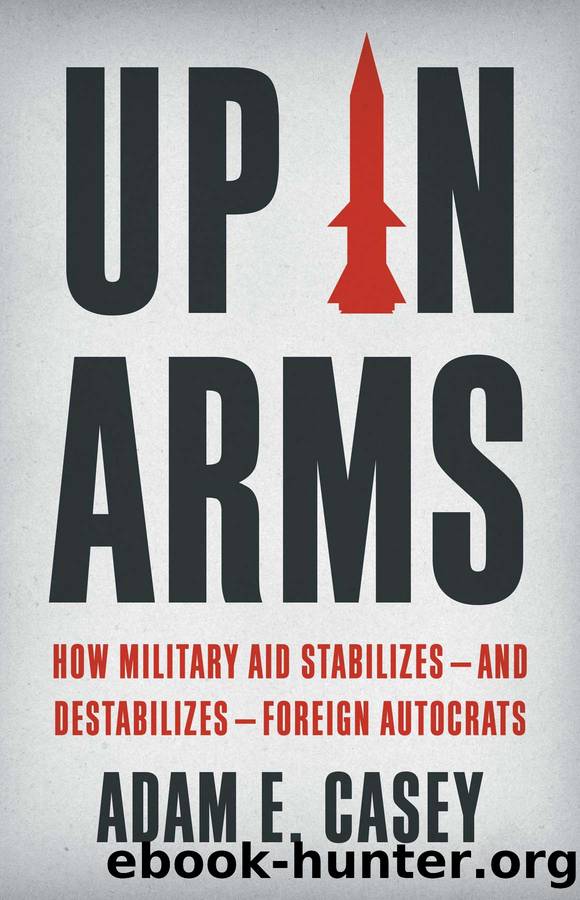Up in Arms by Adam E Casey

Author:Adam E Casey [E. Casey, Adam]
Language: eng
Format: epub
Publisher: Basic Books
Published: 2024-04-03T00:00:00+00:00
NGO DINH DIEM WAS NOT THE ONLY AMERICAN-BACKED AUTOCRAT who would find that the army strengthened by his American patrons would prove lethal to his rule. The United States armed, advised, and organized the Thai military beginning in 1950. This army was organized along American lines, with emphasis put on a nonpartisan orientation and a cohesive, autonomous organization. However, the army built by the United States proved remarkably praetorian. Thailand experienced a dizzying number of coups and coup plots in the twentieth century, many while advised and assisted by the United States. The army strengthened and organized with American aid would come to dominate Thai political life long after American policymakers tired of bankrolling military despots in Bangkok. The Thai army rules to this very day and has again come to enjoy increasingly close American ties. While not yet experiencing a rapprochement reminiscent of Cold Warâera closeness, US-Thai defense ties are likely to continue to strengthen as the Sino-American rivalry heats up.
Initial interest in Thailand by the new postwar superpower was minimal. The seizure of power in a military coup dâétat by Field Marshal Plaek Phibunsongkhram (usually referred to as âPhibunâ or âPibulâ) in November 1947 âcould not have more exasperated the United States.â Phibun had allied himself with fascist Japan in the Second World War and was strongly disliked by the United States and other Western allies. His return to power was âactively opposedâ by London and Washington. At the same time, US pressure against his government was limited by the marginality of Thailand to the newly US-led global order. Linkages to be exploited for leverage against the Thai junta were sparse. Instead, the United States adopted a cool posture and did not officially recognize the government until March the following year.25
The US government refused to hold its nose and support Phibunâs avowedly anticommunist regime because it was not yet convinced Thailand faced a serious communist threat. While the Communist Party of Thailand (CPT) had been founded in 1926, it was a small party almost completely dominated by its Chinese Communist Party (CCP) sponsors. It was also limited by its almost exclusive recruitment among ethnic Chinese in Thailand, which, while a sizable minority, limited its appeal among ethnic Thais. In 1947, the situation in neighboring Indochina was not yet dire, although American concerns about the Viet Minh and the prospects of the French counterinsurgency were mounting. Within Thailand the picture was more optimisticâthe small CPT was still marginal, Thailandâs economy was relatively strong, and the lack of a history of colonization had dampened support for communist mobilization against the existing regime.26
However, by the spring of 1948, American concern for the region more generally and Thailand specifically grew rapidly. The victory of the CCP in the Chinese Civil War in 1949 and Viet Minh gains rendered an anticommunist government in Bangkok suddenly much more attractive. Washington made good on this growing rapprochement with the Thai military leadership by extending $10 million in military aid in January 1950 and economic aid shortly thereafter.
Download
This site does not store any files on its server. We only index and link to content provided by other sites. Please contact the content providers to delete copyright contents if any and email us, we'll remove relevant links or contents immediately.
| Arms Control | Diplomacy |
| Security | Trades & Tariffs |
| Treaties | African |
| Asian | Australian & Oceanian |
| Canadian | Caribbean & Latin American |
| European | Middle Eastern |
| Russian & Former Soviet Union |
The Secret History by Donna Tartt(18838)
The Social Justice Warrior Handbook by Lisa De Pasquale(12141)
Thirteen Reasons Why by Jay Asher(8790)
This Is How You Lose Her by Junot Diaz(6777)
Weapons of Math Destruction by Cathy O'Neil(6139)
Zero to One by Peter Thiel(5684)
Beartown by Fredrik Backman(5594)
The Myth of the Strong Leader by Archie Brown(5420)
The Fire Next Time by James Baldwin(5246)
How Democracies Die by Steven Levitsky & Daniel Ziblatt(5127)
Promise Me, Dad by Joe Biden(5087)
Stone's Rules by Roger Stone(5026)
100 Deadly Skills by Clint Emerson(4840)
A Higher Loyalty: Truth, Lies, and Leadership by James Comey(4839)
Rise and Kill First by Ronen Bergman(4701)
Secrecy World by Jake Bernstein(4639)
The David Icke Guide to the Global Conspiracy (and how to end it) by David Icke(4624)
The Farm by Tom Rob Smith(4434)
The Doomsday Machine by Daniel Ellsberg(4415)
